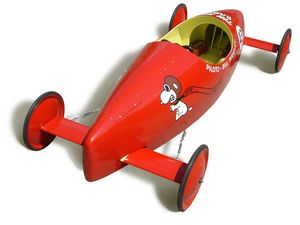.
Soap Box Derby racer

| |
| Soap Box Racer | |
|---|---|
| All American Soap Box Derby | |
| Class | Downhill race car |
| Body type | Open-wheel, single occupant |
| Length | 85 in. (aprox.) |
| Height | 36 in. (max.) |
| Wheelbase | 65 in. (min.) |
| Weight | 150 lbs. (est.) |
| Propulsion | gravity |
| Materials | Wood, fibreglass, steel |
| Top speed | 30 mph (est.) |
Description
A Soap Box Derby racer or soapbox cart is a motor-less vehicle capable of holding a driver (usually a child) that is built for the purpose of recreational racing. Propelled by gravity down a gentle, sometimes steep slope, a soap box racer can reach speeds upwards of 30 miles per hour. Originally, soapbox cars were built from orange crates and roller-skate wheels, but have grown more sophisticated over time, with materials like aluminium and fiberglass being utilized.
In the United Kingdom a soapbox racer is called a buggy, trolley, cart or cartie; in Scotland, a bogie; and in Australia, a billy cart. It is also sometimes called a go-kart, although that term properly refers to an entirely different, open-cockpit vehicle that is equipped with a motor.
In addition to being something often built by children, there are organised competitions and races, the "Soap Box derby", that often invites the participation of an adult mentor or parent, and even an entire family, and are usually entered into in a spirit of fun rather than serious competition. Often these will be fund-raisers for charity.
History of the Soap Box Derby
In 1933, Dayton Daily News newspaper photographer Myron Scott of Dayton, Ohio had covered a race of boy-built cars in his home community and was so taken with the idea that he acquired rights to the event; the All American Soap Box Derby grew out of this idea. In 1934, Scott had managed to persuade fifty cities across the United States to hold soap box car races and send a champion each to Dayton for a major race, later held in Akron.
In the UK, soap box derbies have recently become more popular, brought to the masses by large events such as the Red Bull race and that held between 2000 and 2004 at the Goodwood Festival of Speed. Now, many small hilly communities organise their own races, such as the Catterline Cartie Challenge in Scotland and the Belchford Downhill Challenge in Lincolnshire.
General rules
- The car must have no mechanical propulsion system such as an internal combustion engine or electric motor
- The car must have at least 4 wheels
- The car must have some type of rudimentary brake system
- For obvious safety reasons, the driver must wear a helmet
- Car and driver must weigh in at an average of no more than 250 lbs.
kits are around $450 for modern day cars
Construction
A typical soap-box cart is made of wood, and has four wheels, arranged as a fixed rear axle, and a steerable front beam axle - usually with a very simple single central pivot. A seat is arranged at the back, and perhaps the seat area is enclosed, as in the original soap-box design. More sophisticated designs might employ a fully-enclosed body. The types of wheels employed vary according to what can be obtained easily - wheels from baby carriages, pushchairs, prams, and discarded bicycles being common. Ready-made wheels are also available from hardware suppliers. Steering is typically effected using foot control, or perhaps using a rope connected to the ends of the steerable beam (which can then double as a useful manual pulling device).
More sophisticated steering methods are rarely seen. Brakes are also not commonly used, though some soap-box cart racing contests require these. Often a simple friction brake operated by a lever which bears on one of the tires is all that is needed, which will be of dubious effectiveness.
Soap-box cars are un-powered, and are either pushed by willing helpers, or are run down a suitable slope. Races will usually take place downhill and the most efficient and skillfully driven car will win - gravity applying equally to all.
Soap-box cars also make great construction projects for children, requiring only an intuitive sense of engineering, and a few basic construction skills. There are also pre-designed kits available, though for many this defeats the purpose of the exercise.
See also
| Wikimedia Commons has media related to: |
External links
- All-American Soap Box Derby
- Category at ODP
- The Catterline Cartie Challenge. - Cartie racing near Stonehaven in the North East of Scotland.
- Soap box racing in Belchford, Lincolnshire, UK.


